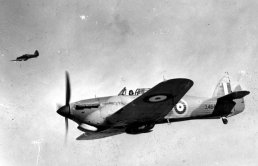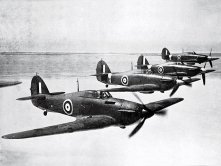
Hawker Hurricane
Merlin XXs were first fitted to a Hurricane Mk I in 1940. The re-engined fighter immediately demostrated a 32 km/h (20 m.p.h) speed improvement over the Mk I and entered production as the Mk IIA. It was soon joined by the Mk IIB with 12 7.7 mm (0.303 cal) machine-guns. During 1941 Mk IIs began fighter and later fighter-bombers sweeps over France, the latter armed with up to 454 kg (1,000 lb) of bombs. Other units performed 'Channel Stop' anti-shipping patrols. In autumn 1941, Mk IIAs and IIBs were sent to the Eastern Front. With the emphasis moving forward the Hurricane as a ground attacker, new armament (four 20 mm/0.79 in) cannon was introduced.
From April, the Mk IIC entered day-fighter service; from August, night-fighter units were also equipped. From late 1941, the Mk IID was available, primarily as an anti-tank aircraft armed with two Vickers 40 mm (1.57 in) cannon. They proved effective both in Burma and the Western Dessert.
In 1943, on the Mk IV, a 'universal' wing was introduced for adaptation in the field. Mk IVs carried 40 mm (1.57 in) cannon, drop tanks, or two 113 kgs (250 lbs) or 227 kg (500 lbs) bombs. Extra armour was also fitted. It was the MK IVs, entering service in 1943, that pioneered the use of 27 kg (60 lbs) rocket armament in the RAF.
British fighter development during World War II, like that of the other combatants, centred on improvements in engine power output and armament firepower. Hawker's Hurricane was typical in this respect. Although outclassed as an interceptor by 1941, the Rolls-Royce Merlin powered Hurricane, armed with cannon and rockets, went on to serve as a valuable fighter bomber in Europe, the Far East and North Africa.
 |
 |
 |
| No. 247 'China British' Squadron was one of five RAF squadrons equipped with cannon-armed Mk IICs for raids over France and the Low Countries. |
Persia ordered Hurricanes in 1939, but their delivery was delayed until after World War II. This two-seat Mk IIC trainer was among them. |
Fighter-bomber Hurricane Mk IIs and IVs remained in production in Britain and Canada for the duration of World War II, serving with home-based and overseas RAF squadrons. |
|
Hawker Hurricane (Technical Specification) |
| Role |
Fighter and fighter bomber |
| Manufacturer |
Hawker |
| Maximum Speed |
541 kmh (335 mph) |
| Maximum Range |
740 km (460 miles) |
| Ceiling |
10,850 meters (35,600 feet) |
Weight
Empty
Maximum Takeoff |
2,631 kg (5,788 lbs)
3,674 kg (8,083 lbs) |
Dimensions
Wingspan
Length
Height
Wing Area |
12.19 meters (40 ft)
9.75 meters (32 ft)
3.99 meters (13 ft 1 in)
23.92 square meters (257 sq ft) |
| Engines |
One Rolls-Royce Merlin XX liquid-cooled piston engine which provides 954-kW (1,280-hp) |
| Armament |
Four Hispano or Oerlikon 20 mm (0.79 in) cannon and underwing racks for two 113 kg (250 lbs) or 227 kg (500 lbs) bombs |
Photo Gallery
Click here to submit your photo
| Have A Passion For Aircraft? |
Subscribe to our 14 series FREE newsletter
delivered weekly on World War 2 Aircraft factfile... |
| NB:- We hate spam as much as you do, so your email address will NEVER be shared with or sold to anyone else. That's a Guarantee. |
|
|





